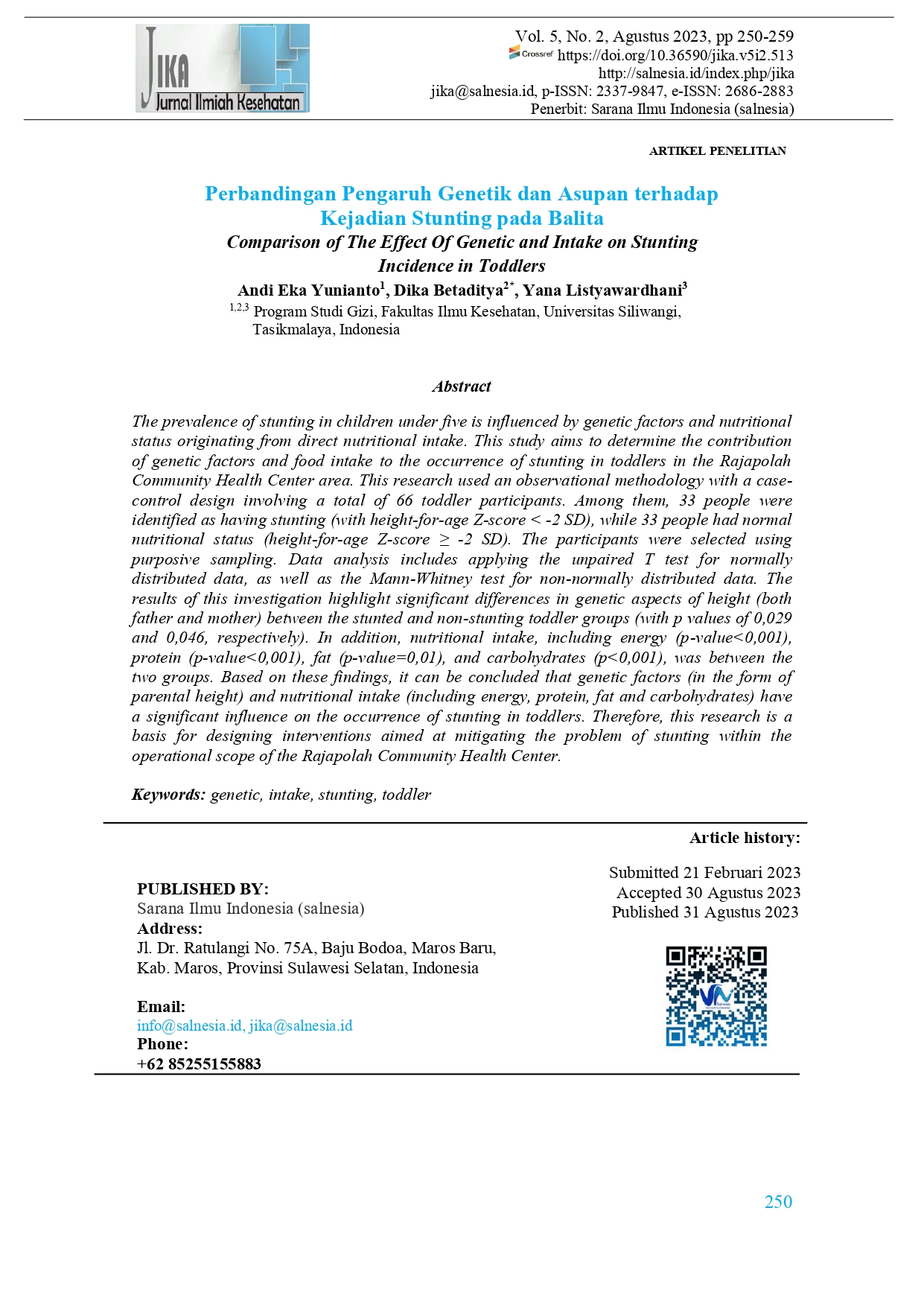Comparison of The Effect of Genetic and Intake on Stunting Incidence in Toddlers
DOI:
https://doi.org/10.36590/jika.v5i2.513Keywords:
genetic, intake, stunting, toddlerAbstract
The prevalence of stunting in children under five is influenced by genetic factors and nutritional status originating from direct nutritional intake. This study aims to determine the contribution of genetic factors and food intake to the occurrence of stunting in toddlers in the Rajapolah Community Health Center area. This research used an observational methodology with a case-control design involving a total of 66 toddler participants. Among them, 33 people were identified as having stunting (with height-for-age Z-score < -2 SD), while 33 people had normal nutritional status (height-for-age Z-score => -2 SD). The participants were selected using purposive sampling. Data analysis includes applying the unpaired T test for normally distributed data, as well as the Mann-Whitney test for non-normally distributed data. The results of this investigation highlight significant differences in genetic aspects of height (both father and mother) between the stunted and non-stunting toddler groups (with p values of 0,029 and 0.046, respectively). In addition, nutritional intake, including energy (p-value<0,001), protein (p-value<0,001), fat (p-value=0,01), and carbohydrates (p<0,001), was between the two groups. Based on these findings, it can be concluded that genetic factors (in the form of parental height) and nutritional intake (including energy, protein, fat and carbohydrates) have a significant influence on the occurrence of stunting in toddlers. Therefore, this research is a basis for designing interventions aimed at mitigating the problem of stunting within the operational scope of the Rajapolah Community Health Center.
Downloads
References
Beal T, Tumilowicz A, Sutrisna A, Izwardy D, Neufeld LM. 2018. A Review of Child Stunting Determinants in Indonesia. Maternal and Child Nutrition. 14(4) : 1-10. https://doi.org/10.1111%2Fmcn.12617
Darawati M, Yunianto AE, Sulendri NKS, Omdah. 2020. Stunting Prevention Through Participative Counselling on the Implementation of Balanced Nutrition Toward Children by Involving Local Puppeteers in Central Lombok Regency, West Nusa Tenggara. Systematic Reviews in Pharmacy. 11(11): 805–810.
De Onis M, Branca F. 2016. Childhood Stunting: A Global Perspective. Maternal and Child Nutrition. 12: 12–26. https://doi.org/10.1111/mcn.12231.
Essa WY, Nurfindarti E, Ruhyana NF. 2021. Strategies for Handling Stunting in Bandung City. Jurnal Bina Praja. 13(1): 15–28. https://doi.org/10.21787/jbp.13.2021.15-28.
Fatima S, Manzoor I, Joya AM, Arif S, Qayyum S. 2020. Stunting and Associated Factors in Children of Less Than Five Years: A Hospital-Based Study. Pakistan Journal of Medical Sciences. 36(3): 581-585. https://doi.org/10.12669/pjms.36.3.1370.
Febrina Suci Hati, Arantika Meidya Pratiwi. 2019. The Effect of Education Giving on the Parent’s Behaviour about Growth Stimulation in Children Stunting. NurseLine Journal, 4(1): 12–20. https://doi.org/10.19184/nlj.v4i1.8628.
Halim F, Ermiati, Sari EA. 2021. Factors of Stunting in Toddlers: A Literature Review. Journal of Nursing Care. 4(1): 285–294. https://doi.org/10.24198/jnc.v4i1.27498.
Huriah T, Nurjannah N. 2020. Risk Factors of Stunting in Developing Countries: A Scoping Review. Open Access Macedonian Journal of Medical Sciences. 8(F): 155–160. https://doi.org/10.3889/oamjms.2020.4466.
Kemenkes [Kementerian Kesehatan]. 2019. Laporan Nasional Riset Kesehatan Dasar 2018. Jakarta: Kementerian Kesehatan Republik Indonesia.
Kusdalinah K, Suryani D. 2021. Asupan Zat Gizi Makro dan Mikro pada Anak Sekolah Dasar yang Stunting di Kota Bengkulu. AcTion: Aceh Nutrition Journal. Politeknik Kesehatan Kemenkes Aceh. 6(1): 93-99. https://doi.org/10.30867/action.v6i1.385.
Kusuma KE, Nuryanto. 2013. Faktor Risiko Kejadian Stunting pada Anak Usia 2-3 Tahun (Studi di Kecamatan Semarang Timur). Journal of Nutrition College. 2(4): 523-530.
Laksono AD, Wulandari RD, Amaliah N, Wisnuwardani RW. 2022. Stunting Among Children Under Two Years in Indonesia: Does Maternal Education Matter? PLoS ONE. 17(7): 1–11. https://doi.org/10.1371/journal.pone.0271509.
Leksananingsih H, Iskandar S, Siswati T. 2017. Berat Badan, Panjang Badan dan Faktor Genetik sebagai Prediktor Terjadinya Stunted pada Anak Sekolah. Jurnal Nutrisia. 19(2): 95–99.
Nabuasa CD, Juffrie M, Huriyati E. 2016. Riwayat Pola Asuh, Pola Makan, Asupan Zat Gizi Berhubungan dengan Stunting pada Anak 24–59 Bulan di Biboki Utara, Timor Tengah Utara, Nusa Tenggara Timur. Jurnal Gizi dan Dietetik Indonesia. 1(3): 151–163. http://dx.doi.org/10.21927/ijnd.2013.1(3): 151-163.
Nshimyiryo A, Hedt-Gauthier B, Mutaganzwa C, Kirk CM, Beck K, Ndayisaba A, Mubiligi J, Kateera F, El-Khatib Z. 2019. Risk Factors for Stunting Among Children Under Five Years: A Cross-Sectional Population-Based Study in Rwanda Using the 2015 Demographic and Health Survey. BMC Public Health. 19(1): 1–10. https://doi.org/10.1186/s12889-019-6504-z.
Quamme SH, Iversen PO. 2022. Prevalence of Child Stunting in Sub-Saharan Africa and Its Risk Factors. Clinical Nutrition Open Science. 42: 49–61. https://doi.org/10.1016/j.nutos.2022.01.009.
Sastria Ahmad A, Azis A, Fadli. 2021. Analysis of Risk Factors for the Incidence of Stunting in Toddlers. Journal Of Health Science And Prevention. 5(1): 10–14. https://doi.org/10.29080/jhsp.v5i1.415.
Titaley CR, Ariawan I, Hapsari D, Muasyaroh A, Dibley MJ. 2019. Determinants of the Stunting of Children Under Two Years Old in Indonesia: A Multilevel Analysis of the 2013 Indonesia Basic Health Survey. Nutrients. 11(5): 1-13. https://doi.org/10.3390/nu11051106.
Vaivada T, Akseer N, Akseer S, Somaskandan A, Stefopulos M, Bhutta ZA. 2020. Stunting in Childhood: An Overview of Global Burden, Trends, Determinants, and Drivers of Decline. The American Journal of Clinical Nutrition. 112: 777S-791S. https://doi.org/10.1093/ajcn/nqaa159.
Wiwid Andari, Tri Siswati, Bunga Astria Paramashanti. 2020. Tinggi Badan Ibu sebagai Faktor Risiko Stunting pada Anak Usia 24-59 Bulan di Kecamatan Pleret dan Kecamatan Pajangan Kabupaten Bantul Yogyakarta. Journal of Nutrition. 9(4): 235–240. https://doi.org/10.14710/jnc.v9i4.26992.
Yulianti Wulan Sari, Bambang Wirjatmadi, Stefani Widya Setyaningtyas. 2021. Hubungan Tingkat Kecukupan Zat Gizi Makro, Personal Hygiene Ibu, Sanitasi Lingkungan dan Diare dengan Kejadian Stunting Balita Usia 24-59 Bulan. [Skripsi]. Surabaya: Universitas Airlangga.
Yushananta P, Ahyanti M. 2022. Risk Factors of Stunting in Children Aged 6–59 Months: A Case-Control Study in Horticulture Area. Journal of Medical Sciences. 10(E): 1–5. https://doi.org/10.3889/oamjms.2022.7768.
Yusni Adani F, Susila Nindya T. 2017. Perbedaan Asupan Energi, Protein, Zink, dan Perkembangan pada Balita Stunting dan Non Stunting. Amerta Nutrition. 1(2): 46–51. https://doi.org/10.2473/amnt.v1i2.2017.46-51.

Downloads
Published
How to Cite
Issue
Section
License
Copyright (c) 2023 Andi Eka Yunianto, Dika Betaditya, Yana Listyawardhani

This work is licensed under a Creative Commons Attribution 4.0 International License.








